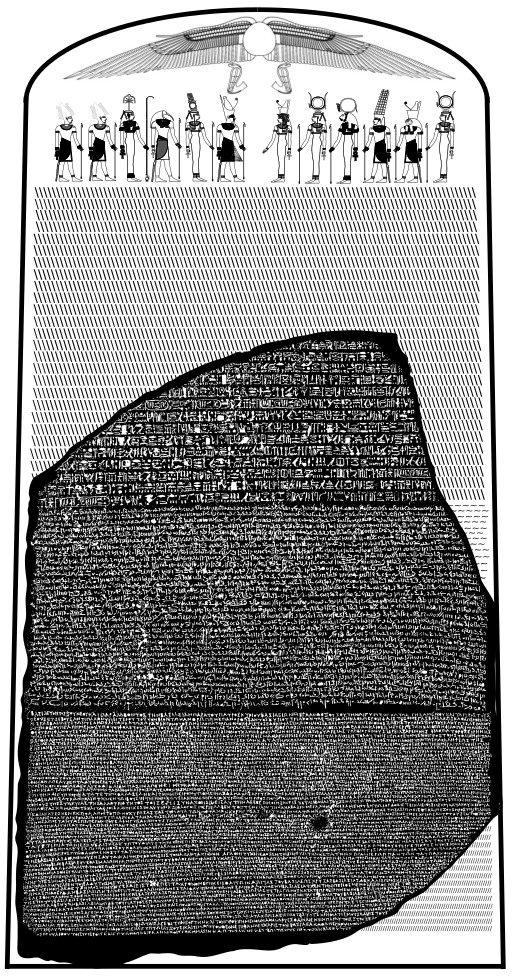Without the Rosetta Stone, We Don’t Know About Ancient Egypt
The Rosetta Stone was discovered by the French, Captain Pierre François Xavier Bouchard in 1799, during a war led by Napoleon Bonaparte. The site of the discovery of this stone in Fort St. Julien in El-Rashid, Egypt and this Stone is thought to have been made in 196 BC. The text was only translated in 1822 by Jean-François Champollion.
This article will explore the history of the Rosetta Stone, its discovery, and the impact it has had on our understanding of ancient Egypt.
The Rosetta Stone is one of the most important archaeological discoveries in modern science. Because this stone is the key that could open the civilization of the past. With the discovery of this stone, one step further, perhaps, we can see the truth of history.
The Rosetta Stone is a granodiorite stone (similar to granite) that helps modern researchers in the translation of ancient texts in 2 Egyptian and Greek writings. The stone uses three scripts, namely hieroglyphics, Egyptian Demotic and Greek.
Definition:
– Hieroglyphics is the formal writing system used by the ancient Egyptians of Egypt.
– Demotic (from dimotika) refers to Ancient Egyptian scripts of northern hieratic origin used in the Nile Delta. It is also a stage of the Egyptian language that continued with the “Late Egyptian” language and was replaced by the “Coptic” language.
The Rosetta Stone is now in the British Museum – London.
Rosetta Stone and the Translation Business
In 1814, the Englishman Thomas Young finished translating the enchorial (demotic) text and began work on hieroglyphic manuscripts, but he was unsuccessful in translating the passage.
From 1822-1824, a French researcher, Jean-François Champollion, expanded his research and translation efforts of this stone by working with other translators. They are usually cited as the main translators of the Rosetta Stone, such as:
- Athanasius Kircher
- Silvestre de Sacy
- Johan David Akerblad
- William John Bankes
Champollion could read both Greek and Coptic, and knew what the seven Demotic signs in Coptic were. By looking at how the signs were used in Coptic, he worked to figure out what they meant. Then he traced the Demotic signs back to the hieroglyphic marks.
By examining several hieroglyphs, he translated texts from Demotic (or more Coptic) and Greek to hieroglyphics by first translating the original Greek name in Greek. Then he worked on ancient names that were never written in any other language. Champollion then created an alphabet outlining the remaining text.
In 1858, the Philomathean Society of the University of Pennsylvania published the first complete English translation of the Rosetta Stone as did three scholarly members: Charles R Hale, S Huntington Jones, and Henry Morton.
Egypt Dynasty | Timeline, List of Egyptian Ancient dynasties and Pharaohs
The Contents of the Rosetta Stone
The contents of this Rosetta stone are a decree issued by the priests in the general assembly in the great city of Memphis, at the time of commemorating the first 8 years of the reign of Ptomely V. The statement is a series of Ptolemy V’s titles as king throughout northern and southern Egypt. The statement was compiled on the 4th day of the Greek month Kandikas, 196 BC.
It has also been mentioned in the inscription, a series of praises and good deeds of the king in connection with his commendable actions and attitudes towards the gods, the Egyptian people and the state.
King Ptomely V was a king figure who became the praise of the Egyptian people so that in the trial it was decided to carry out several things as a sign of gratitude to the king. Among them are, making statues & celebrating the coronation & birth of Ptolemy V (also known as Ptolemy Epiphanes, was a pharaoh of Egypt who reigned from 204 to 180 BCE). However, the realization of all that is still in doubt.

A reconstruction of the stela of which the Rosetta Stone was originally a part. A. Parrot, CC BY-SA 4.0, via Wikimedia Commons
Egyptian Hieroglyphic Writing Are Using Figuratives Alphabet System | Secret and History
Impact
The discovery and translation of the Rosetta Stone had a profound impact on our understanding of ancient Egypt. It allowed scholars to read ancient texts, understand religious practices, and gain insights into the daily life of the people who lived in this fascinating civilization. The Rosetta Stone has also had a lasting impact on the field of archaeology and the study of ancient cultures in general, serving as a model for how to approach the study of inscriptions and texts.
Conclusion
The Rosetta Stone remains one of the most important artifacts in the world, and its significance cannot be overstated. Without it, we would know very little about the ancient Egyptians and their culture. Its discovery and translation have opened up a window into the past, and have allowed us to gain a deeper appreciation for the richness and complexity of this remarkable civilization.
Sources: PinterPandai, Khan Academy, Unexplained Mysteries, All About Archaelogy
Photo credit (main picture): © Hans Hillewaert (CC BY-SA 4.0) via Wikimedia Commons



